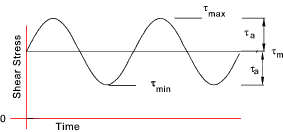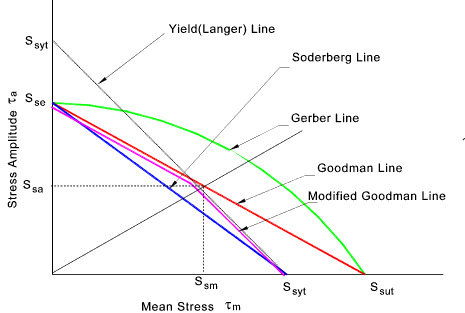Machine_Parts_Index
Spring Index Spring Fatigue Notes
|
Introduction Note:
Nomenclature
Fatigue Notes The normal shear stress condition experienced be a spring subject to continuous fluctuating loading is as shown below
The force amplitude and mean value are calculated as
The resulting alternating and mean stresses are
For springs the safety factor for torsional endurance life is
Experimental results have proved that for spring steel the torsional endurance limit is not directly related to size, tensile strength, or material for wires under 10mm diameter. The resulting value from experiments has been determined as S'se = 310 MPa for unpeened springs and 465 MPa for peened springs S'sa = 241 MPa for unpeened springs and 398 MPa for peened springs S'sm = 379 MPa for unpeened springs and 534 MPa for peened springs
These values include all modifying factors except for the reliability factor. ref Fatigue modifying factors That is Se = CrS'e
It is generally safe to use a torsional yield strength of 40% of the ultimate
tensile strength i.e Ssyof 0,4Sut ref notes Spring Materials
Ssf is the modified shear fatigue strength. This can be determined approximately
if the endurance limit( S'se ) and the fatigue strength at 103 cycles ( S'sl ) are available ref High cycle fatigue strength
Goodmans failure criterion.. The fatigue design of springs generally involves one of a number of failure criterions, as shown below.
The intersect equation for the Goodmans criterion is
The relevant factor of safety is calculated as follows
|
Links to Spring Design
|
|
Machine_Parts_Index
Spring Index


